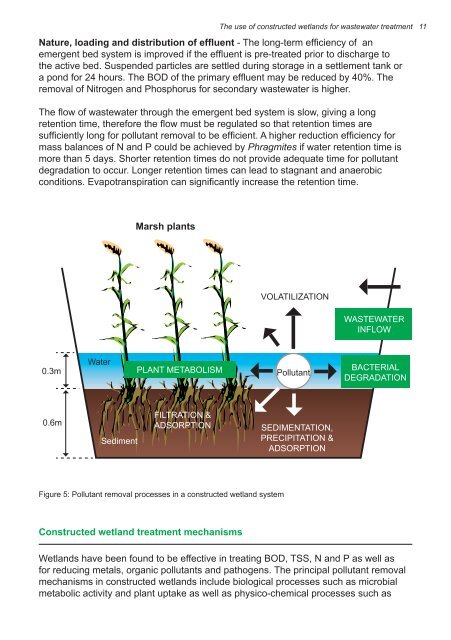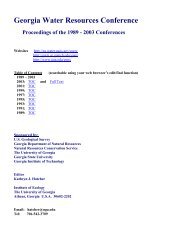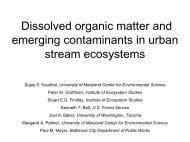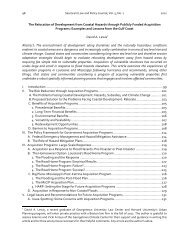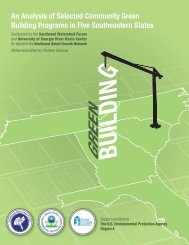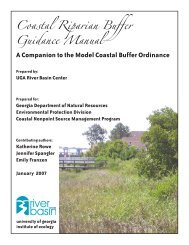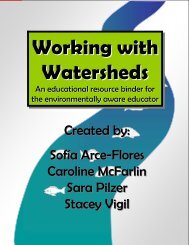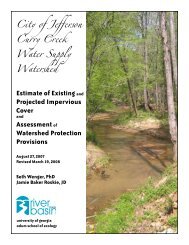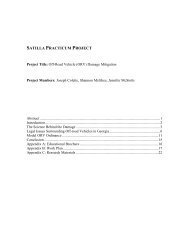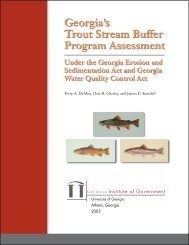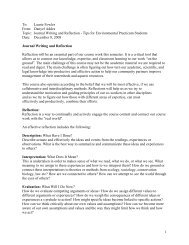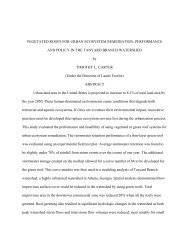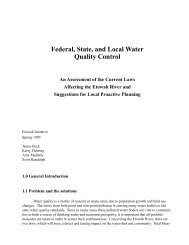The use of constructed wetlands for wastewater treatment
The use of constructed wetlands for wastewater treatment
The use of constructed wetlands for wastewater treatment
Create successful ePaper yourself
Turn your PDF publications into a flip-book with our unique Google optimized e-Paper software.
<strong>The</strong> <strong>use</strong> <strong>of</strong> <strong>constructed</strong> <strong>wetlands</strong> <strong>for</strong> <strong>wastewater</strong> <strong>treatment</strong> 11<br />
Nature, loading and distribution <strong>of</strong> effluent - <strong>The</strong> long-term efficiency <strong>of</strong> an<br />
emergent bed system is improved if the effluent is pre-treated prior to discharge to<br />
the active bed. Suspended particles are settled during storage in a settlement tank or<br />
a pond <strong>for</strong> 24 hours. <strong>The</strong> BOD <strong>of</strong> the primary effluent may be reduced by 40%. <strong>The</strong><br />
removal <strong>of</strong> Nitrogen and Phosphorus <strong>for</strong> secondary <strong>wastewater</strong> is higher.<br />
<strong>The</strong> flow <strong>of</strong> <strong>wastewater</strong> through the emergent bed system is slow, giving a long<br />
retention time, there<strong>for</strong>e the flow must be regulated so that retention times are<br />
sufficiently long <strong>for</strong> pollutant removal to be efficient. A higher reduction efficiency <strong>for</strong><br />
mass balances <strong>of</strong> N and P could be achieved by Phragmites if water retention time is<br />
more than 5 days. Shorter retention times do not provide adequate time <strong>for</strong> pollutant<br />
degradation to occur. Longer retention times can lead to stagnant and anaerobic<br />
conditions. Evapotranspiration can significantly increase the retention time.<br />
Marsh plants<br />
VOLATILIZATION<br />
WASTEWATER<br />
INFLOW<br />
0.3m<br />
Water<br />
PLANT METABOLISM<br />
Pollutant<br />
BACTERIAL<br />
DEGRADATION<br />
0.6m<br />
Sediment<br />
FILTRATION &<br />
ADSORPTION<br />
SEDIMENTATION,<br />
PRECIPITATION &<br />
ADSORPTION<br />
Sediment<br />
Figure 5: Pollutant removal processes in a <strong>constructed</strong> wetland system<br />
Constructed wetland <strong>treatment</strong> mechanisms<br />
Wetlands have been found to be effective in treating BOD, TSS, N and P as well as<br />
<strong>for</strong> reducing metals, organic pollutants and pathogens. <strong>The</strong> principal pollutant removal<br />
mechanisms in <strong>constructed</strong> <strong>wetlands</strong> include biological processes such as microbial<br />
metabolic activity and plant uptake as well as physico-chemical processes such as


